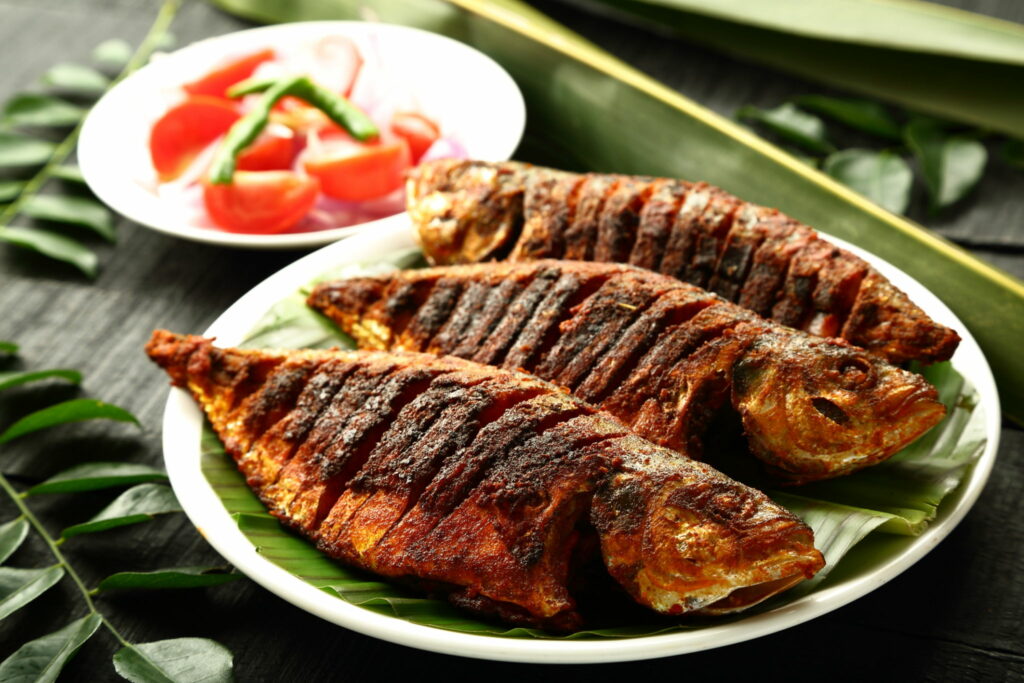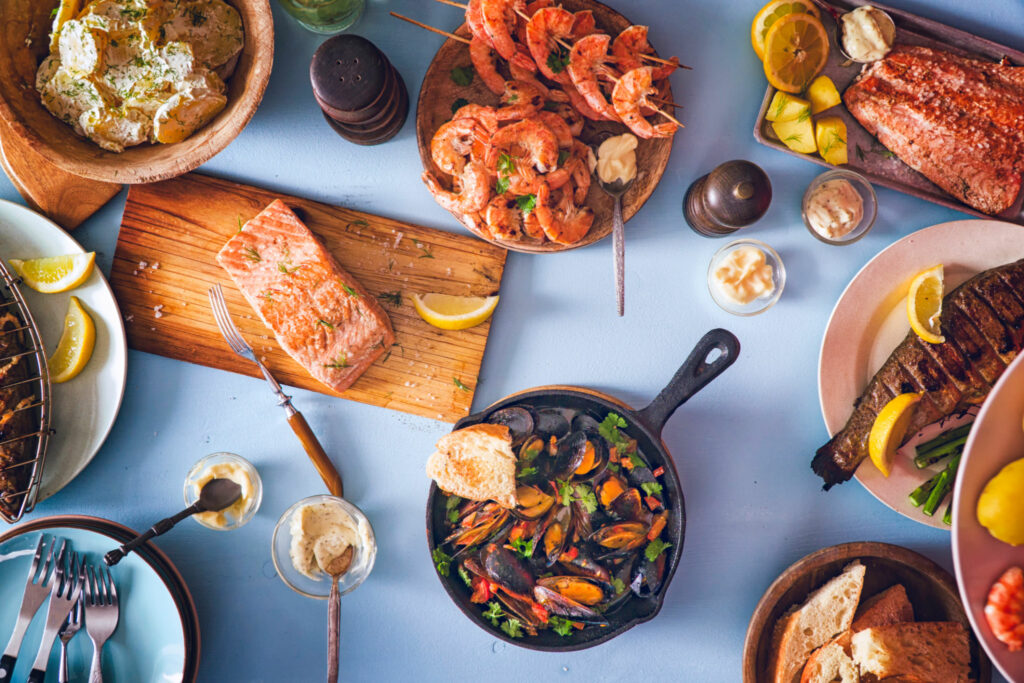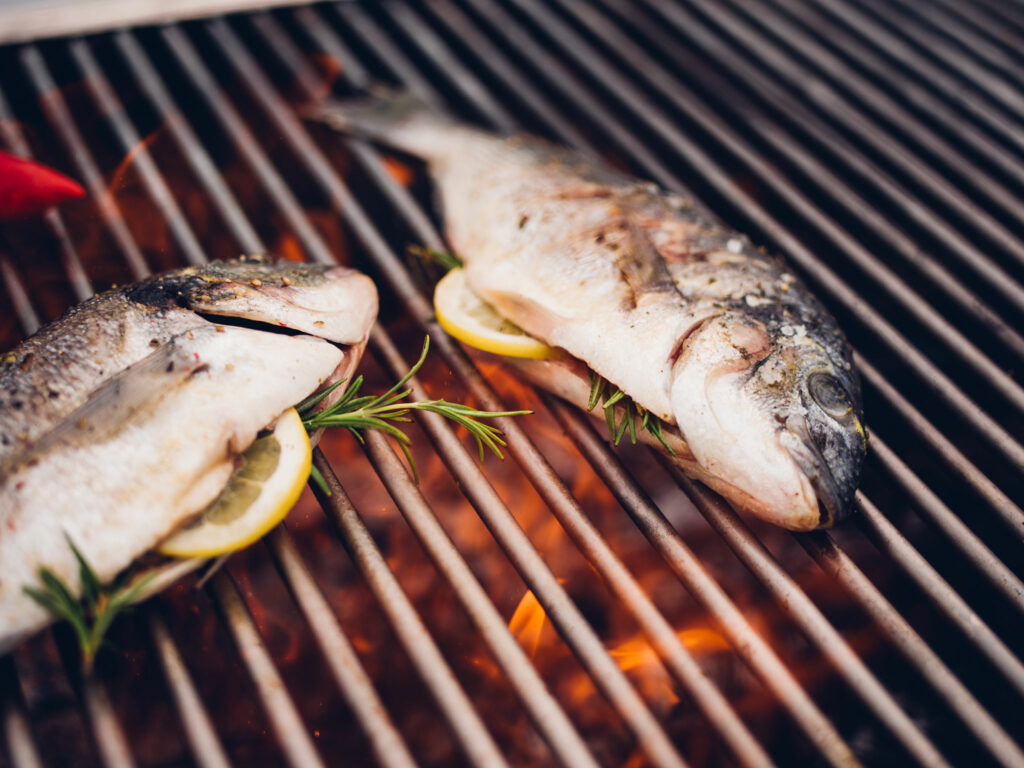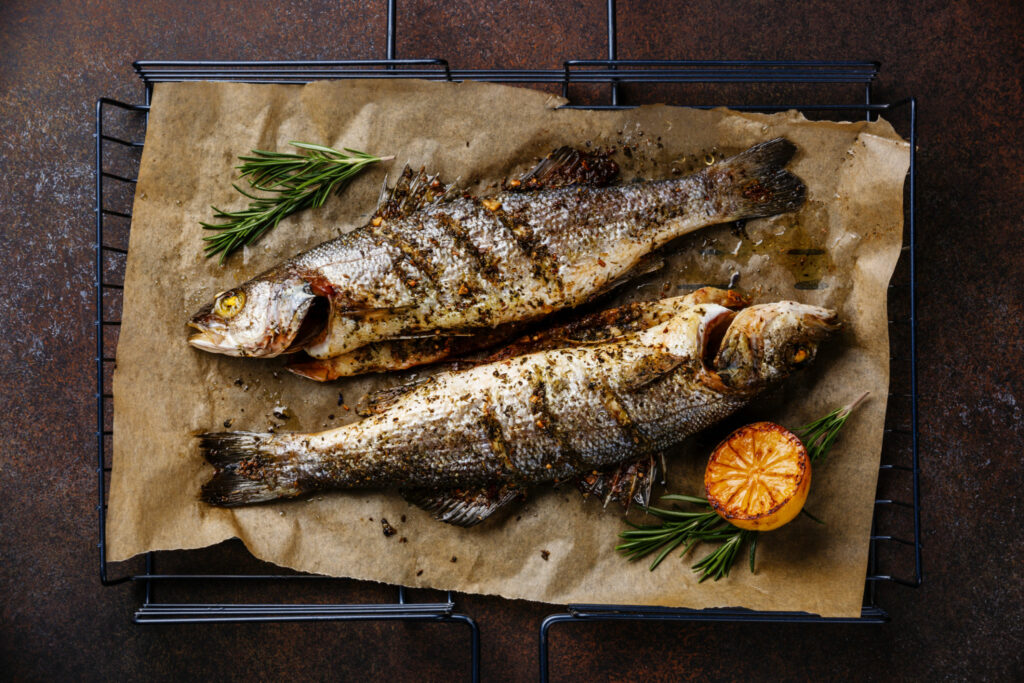Grilling fish and seafood can be a healthy and delicious way to cook your favorite dishes. If you’re on the lookout for some tips on how to grill your seafood, look no further!

In this blog post, I’ll give you a guide on how to grill fish and seafood, as well as some tips on what types of fish and seafood work best when grilled. So, read on to learn more!
Types Of Seafood That Are Great For Grilling!
The great thing about seafood is that there are so many different types that you can grill! Here are a few of my favorites:

1. Salmon:
Salmon is a kind of fish rich in Omega-3 fatty acids, which are great for your health. When grilling salmon, I like to use a marinade or rub to add flavor.
It is important to not overcook salmon, as it can become dry quickly. I would recommend grilling salmon for 4-5 minutes per side. For better knowledge, check out this post on how to make grilled salmon.
2. Shrimp:
You can never go wrong with grilled shrimp! I like to use garlic butter or lemon pepper seasoning when grilling shrimp.
On average, shrimp only takes a few minutes to cook through, so stay away from overcooking them. You’ll know they’re done when they are pink and slightly opaque in color.
3. Scallops:
Scallops, on the other hand, are a little bit more delicate than shrimp. The key to grilling scallops is to not overcook them. It’s best to use a lower heat when grilling scallops so that they do not become tough.
As with shrimp, you will know they are done when they are slightly opaque in color.
4. Tilapia:
Tilapia is one kind of fish that is very versatile. It can be cooked in a variety of ways, but I think grilling tilapia is the best way to enjoy its flavor. When grilling tilapia, I like to use a simple seasoning of salt, pepper, and lemon juice.
Tilapia is a delicate fish, so do not overcook it. It should only be grilled for 3-4 minutes per side.
5. Lobster:
Grilled lobster is a real treat! I like to use a garlic butter or lemon pepper seasoning when grilling lobster. In general, you will want to grill lobster for about 10 minutes or until it is slightly charred and cooked through.
How To Grill Fish And Seafood?

Right now that you know what kinds of fish and seafood are great for grilling, let’s talk about how to grill them! Below, I’ll provide you a step-by-step guide on how to grill fish and seafood.
1. Choose Your Favorite Type Of Fish Or Seafood.
Choosing the right type of fish or seafood is important, as different types have different flavor profiles. Pick a type that you know you will enjoy. When in doubt, salmon, shrimp, and scallops are always a good choice!
2. Prepare Your Fish Or Seafood.
Once you have chosen your fish or seafood, it is time to prepare it for grilling. This may involve cleaning it, marinating it, or seasoning it.
Some people like to use a rub or marinade to add flavor. Others simply season their fish or seafood with salt, pepper, and lemon juice.
3. Preheat Your Grill.
Preheating your grill is an important step in ensuring that your fish or seafood cooks evenly.
Make sure that your grill grates are clean before you start cooking. At this fact, you may also want to brush your grill grates with oil to prevent sticking.
4. Place Your Fish Or Seafood On The Grill.
Once your grill is preheated, it is time to place your fish or seafood on the grates. Be sure to oil the grates beforehand so that the fish or seafood does not stick. In general, you will want to grill your fish or seafood for 4-5 minutes per side.
Close The Lid And Let It Cook.
After you have placed your fish or seafood on the grill, close the lid and let it cook for the recommended amount of time. Depending on the type of fish or seafood, this will be different. For example, thicker cuts of fish like salmon will take longer to cook than thinner cuts like tilapia.
1. Flip Your Fish Or Seafood Halfway Through Cooking.
Halfway through the cooking time, flip your fish or seafood so that it cooks evenly on both sides. When flipping, be cautious not to lose any of the juices or flavors.
2. Remove From Grill And Let Rest.
Once your fish or seafood is cooked through, remove it from the grill and let it rest for a few minutes. Doing this allows the juices to spread, ensuring that your fish or seafood is moist and flavorful. It also allows you to avoid the risk of overcooking.
3. Serve With Your Favorite Sides, And Enjoy!
After your fish or seafood has had a chance to rest, it is time to serve it! I like to serve grilled fish or seafood with a simple salad and some roasted potatoes. You can also get innovative and serve it with your favorite sides. Grilled fish or seafood is also great on its own!
4. Additional Tips:
- If you are using a marinade or rub, be sure to apply it evenly to all sides of the fish or seafood.
- When grilling shrimp, I recommend removing the tails beforehand so that they do not burn on the grill.
- If you are grilling whole fish, be sure to clean and gut it beforehand. You may also want to score the flesh so that the heat can penetrate evenly.
- When cooking scallops, do not to overcook them as they can become tough quickly.
- For extra flavor, try basting your fish or seafood with a favorite sauce while it cooks.
If you want to avoid sticking, be sure to oil your grill grates before cooking. You can also use a non-stick spray.
Tips For Avoiding Overcooked Seafood!

When you are grilling seafood, it is important to avoid overcooking it. This can be tricky, as seafood can go from being cooked to overcook very quickly. Here are a few tips to help you avoid overcooking your seafood:
1. Use Fresh Seafood.
When it comes to grilling seafood, using fresh seafood is always best. This is because fresh seafood is less likely to be overcooked. You can usually find fresh seafood at your local grocery store or fish market.
2. Preheat Your Grill.
Preheating your grill is an important step in ensuring that your seafood cooks evenly. I recommend preheating your grill to 400 degrees Fahrenheit.
Make sure that you grill grates are spotless before you start cooking. In addition, you may want to brush your grill grates with oil to prevent sticking.
3. Use The Right Type Of Fish Or Seafood.
When choosing fish or seafood for grilling, opt for thicker cuts like salmon or tuna. These kinds of fish are less likely to overcook quickly.
Also, be sure to avoid any fish or seafood that is already cooked. This includes things like canned tuna or pre-cooked shrimp.
4. Be Careful With Smaller Pieces Of Seafood.
Smaller pieces of seafood like shrimp and scallops can overcook very quickly. Therefore, it is important to be careful when grilling these items.
5. Grill For The Recommended Time.
Grill your seafood for the recommended amount of time. This will vary depending on the type and thickness of the fish or seafood. On an average, fish or seafood should be grilled for about two minutes per side.
6. Flip Your Seafood Halfway Through Cooking.
To ensure even cooking, be sure to flip your seafood halfway through grilling. Use tongs or a spatula when flipping to avoid losing any juices or flavors.
7. Remove From Grill And Let Rest.
The last step is to remove your seafood from the grill and let it rest for a few minutes. It’ll continue to cook a little bit as it rests, so be sure not to overcook it. You can then serve your seafood with your favorite sides. Enjoy!
Following these tips will help you avoid overcooking your seafood. Grilling seafood can be a bit tricky, but with these tips, you will be sure to succeed!
Conclusion
Seafood is a delicious, healthy option for your next grill out. But it can be tricky to know how to grill fish and seafood properly. With these tips, you’ll have everything you need to make the perfect grilled seafood dish every time.
For even more grilling tips and tricks, be sure to check out the website at GrillCharms.com. Thanks for reading, and happy grilling!
- The 9 Best BBQ Grills for Smoking Brisket - December 29, 2022
- 6 Mouth Watering Grilled Shrimp Recipes - September 16, 2022
- 6 Delicious Grilled Desserts - September 16, 2022
